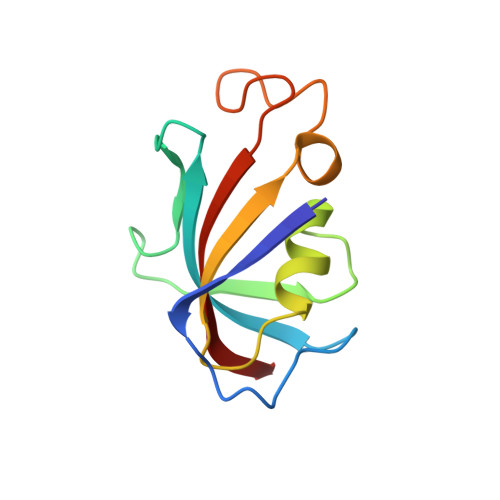Analysing the visible conformational substates of the FK506-binding protein FKBP12.
Mustafi, S.M., Chen, H., Li, H., Lemaster, D.M., Hernandez, G.(2013) Biochem J 453: 371-380
- PubMed: 23688288
- DOI: https://doi.org/10.1042/BJ20130276
- Primary Citation of Related Structures:
4IPX - PubMed Abstract:
The 1H-15N 2D NMR correlation spectrum of the widely studied FK506-binding protein FKBP12 (FK506-binding protein of 12 kDa) contains previously unreported peak doublings for at least 31 residues that arise from a minor conformational state (12% of total) which exchanges with the major conformation with a time constant of 3.0 s at 43°C. The largest differences in chemical shift occur for the 80's loop that forms critical recognition interactions with many of the protein partners for the FKBP family. The residues exhibiting doubling extend into the adjacent strands of the β-sheet, across the active site to the α-helix and into the 50's loop. Each of the seven proline residues adopts a trans-peptide linkage in both the major and minor conformations, indicating that this slow transition is not the result of prolyl isomerization. Many of the residues exhibiting resonance doubling also participate in conformational line-broadening transition(s) that occur ~105-fold more rapidly, proposed previously to arise from a single global process. The 1.70 Å (1 Å=0.1 nm) resolution X-ray structure of the H87V variant is strikingly similar to that of FKBP12, yet this substitution quenches the slow conformational transition throughout the protein while quenching the line-broadening transition for residues near the 80's loop. Line-broadening was also decreased for the residues in the α-helix and 50's loop, whereas line-broadening in the 40's loop was unaffected. The K44V mutation selectively reduces the line-broadening in the 40's loop, verifying that at least three distinct conformational transitions underlie the line-broadening processes of FKBP12.
Organizational Affiliation:
Wadsworth Center, New York State Department of Health, Empire State Plaza, Albany, NY 12201, USA.















